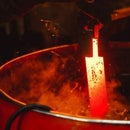Introduction: Annealing Carbon Steels
This is the second Instructable in my series about heat treating carbon steels.
If you read the preceding Instructables: An Introduction To Heat Treating Carbon Steels, then you learned that heat treating is the manipulation of a metal's molecular structure via exposure to specific temperatures. Carbon steel's molecular structure is crystalline and has a grainy appearance. Exposure to heat changes the shape of these crystals. Each crystalline shape exhibits a different set of properties, which can be beneficial in different ways depending on the material's application.
In the simplest terms, annealing is the softening of metal. There are many sub-categories of annealing, but this Instructable will only address it in a general sense. If you want to dive deeper into this subject matter, there will be a list of references at the end of this series.
In the case of annealing, it is the grain (crystal) growth that is desirable.
Step 1: Why Would Steel Need to Be Softened?
Softening steel makes it easier to work with. When steels are purchased, they sometimes come in the annealed state, but not always. Annealing is sometimes necessary before certain machining and drilling operations. Steel also builds up stress over time from wear and tear in parts that have forces exerted on them. This is a phenomena called work-hardening, and annealing can be used to relieve this stress.
This is particularly relevant if you are using found materials for your projects. The internal condition of the grain structure of used steels is impossible to know. What kind of stress did this steel encounter before you found it? Without this pertinent information, using found material can be risky, and a waste of time if stress cracks develop half way through your project and ruin it. Annealing all found materials first is a way to insure that the material will be easier and safer to work with.
Here's a practical example: You buy some used dies for your hydraulic press, but find that the bolt holes are too small and need to be re-drilled to fit your machine. The problem is that steel used to make the die is harder than the steel used to make the drill bit making it impossible to make the holes bigger. However, annealing the die can reduce its hardness to that which is less than the drill bit. Now the drill will be able to cut the die and new holes can be made. After successful annealing, the die can be re-hardened and cleaned back to its original state.
Step 2: Austenite
Above: (top) microscopic view of the different crystal phases. (bottom) the iron / carbon phase diagram.
Everything about annealing revolves around the term austenite. Along with ferrite, cementite, martensite, bainite, and pearlite, austenite is the name given to a crystal phase that forms as steels are heated and cooled. The temperature at which austinite forms is called the critical temperature. Each steel's critical temperature is slightly different, but most are within a few degrees of each other. The range between the critical temp and the melting point is called the transformation range. The low end of this range is around 1333 F, which is close to most steel's critical temp.
Austenite continues to form as the temperature increases to the upper end of the transformation range. The higher the temp and the longer the steel is "soaked", the more austenite is formed. This is important because the amount of austinite dictates the potential softness the annealed steel will have.
The reason why the phase change to austenite is called "critical", is because the formation of austenite is like a metallurgical "reset" button. When the steel is at an austinizing temperature, all of the other crystal phases are transforming into austinite. The transformation creates a homogenization of the gain size and shape and a somewhat uniform spacing around the grains. This is essentially what creates the flexibility and softness in the material.
Step 3: The Process
Before annealing, find the material data for the specific alloy you are working with. If you bought the steel new, then check with the supplier. They should know the materiel's critical temperature, transformation range, mechanical properties, suitable applications, etc.
If you are using scrap steel, then you have some homework to do. Ask yourself these questions : What is the part that you have? Is it an axl? a spring? a shaft? Are there any identifying marks on the steel? What kind of machine did it come from? Can the part be tracked via serial numbers of the machine you pulled it from? If it is an auto part, what was the year/ make / model of the vehicle?
With some effort it is possible to find out what manufactures were using for different applications. The more you know about your steel going into the heat treating process, the more likely it will be that you have a positive and successful outcome.
Annealing:
Once you know what you are working with and what the proper numbers are, then you are ready to anneal.
To maximize a steel's softness, heat it slowly to its transformation range (about 100°F above the steel's critical temp) and soak for the appropriate time. The steel's crystalline structure will begin to form austenite. Generally speaking, proper soak times are 1 hour / every inch of maximum thickness of the piece.
Once the steel has soaked at the correct time / temperature, it is time for cooling. The key to success with annealing is to cool as slowly as possible (specifically, no more than 70° / hr) from the austenizing temperature to about 100°F below the steel's transformation range.
This can be done one of several ways:
- The first method of slow cooling is to quench in some kind of insulating medium. This holds the heat and prevents it from dissipating too quickly. Dry sand and vermiculite are common insulating mediums.
- Another method is forge cooling. If you are using a gas forge as the heat source, simply close the doors and turn the forge off with the steel still inside it. The forge takes a long time to cool off and this is often a long enough period to achieve an annealed state.
- The third option is the most expensive, and requires a programmable, temperature controlled kiln. If you have the resources, a piece of equipment like this can really make your projects go smoothly. Simply dial the machine in and let it bring the temp down over the proper time.
The reason for slow cooling is to allow the carbon in the steel to diffuse out of the austinite and form iron carbide, or cementite, which is soft.
There is a bit of a misconception about the length of time needed for the cooling process. It is widely believed that steel must be cooled off over the longest period of time as possible. This is true, but only in between two specific temperatures: the critical temp (temp where austinite forms) and the bottom of transformation range (about 100°F less than the critical temp). After this point, the steel can be cooled more rapidly to save time.
This can be confusing however, and since exact temperatures are difficult to know without high tech thermometers, AND cooling to room temperature will have no negative side affects, then the safe bet is to simply cool the steel off as slowly as possible.
Step 4: What Does This Mean for the DIY Toolmaker?
While researching this topic, I found that most of the available information was geared towards the industry, which operates in scales that are unrealistic for the average person working in a home shop. The steel mills heat treat material by the ton in industrial, computer controlled furnaces large enough for a tractor trailer. So, how do we scale this down to a practical usability?
Luckily, temperature is a far more important factor than size or quantity when it comes to heat treating. What really matters is the ability to achieve and hold austentetic temperatures safely and affordably, and this can be done in a home shop relatively easily.
A temperature controlled kiln is ideal for this, but they can be expensive to buy and maintain. A gas forge with a pyrometer is more affordable (especially if you build one yourself) but it's still an investment. These types of equipment can run you anywhere from $500 - $5000, not including the cost of energy / fuel.
A lower cost alternative might be a makeshift forge made from fire bricks with an oxy / fuel torch serving as the heat source. If you are on a budget, or your work space does not allow for any of the other equipment, this can be a surprisingly effective method for heat treating.
Blacksmiths have been doing this kind of work for thousands of years without the aid of digital technology. The use of pyrometers, laser thermometers, and environmental controls is nice, but not necessary to be successful at heat treating.
One thing that early metalsmithis learned was that temperature can be deciphered by the color it produces in the material. As steel heats up, it begins to change color. First it changes from black to a dark cherry red. As it heats, the red brightens into a range of oranges and then again into a variety of yellows. This continues until the steel is practically white, at which point it is only a few degrees from melting into a liquid.
The color spectrum can be used to visually judge the temperature of the steel. If you know the austenetic range of your material begins at 1350°F, and that steel glows red around 1300°F, then you can make an educated guess as to the transformation range of the steel as it begins to glow into the orange spectrum. With experience, judging the temperature of the material based on its color will become second nature.
Whatever heat source you end up using, it is of the utmost importance that your work space is up to your local fire codes. That included proper ventilation, access to fire extinguishers, and more than one exit.
Stay tuned for the next heat treating instructable which will focus on normalizing.




